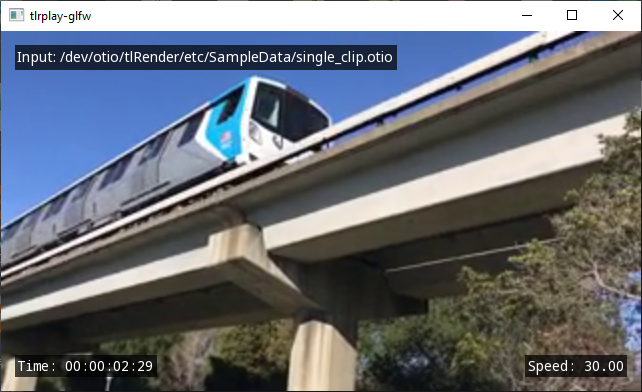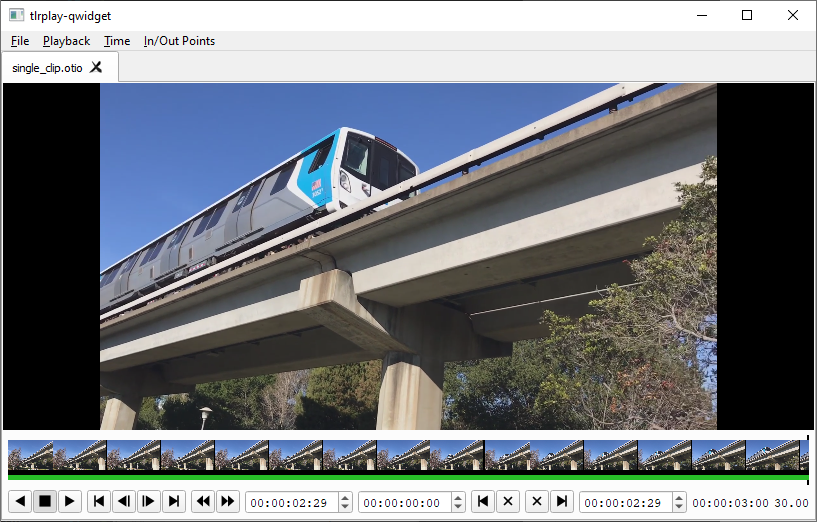tlRender, or timeline render, is an early stage project for rendering editorial timelines.
The project includes libraries for rendering timelines with OpenGL and Qt, and example applications showing the usage of the libraries.
The project is written in C++ and uses OpenTimelineIO (https://github.com/PixarAnimationStudios/OpenTimelineIO) for reading timelines. FFmpeg (https://ffmpeg.org/) and other open source libraries are used for movie and image I/O. The tlRender code is provided under a BSD style open source license.
Supported:
- Movie clips
- Image sequences (Cineon, DPX, JPEG, OpenEXR, PNG, TIFF)
- Transitions
- Gaps
To do:
- Effects
- Audio support
- Hardware movie decoding
- Rendering to file
- Nested timelines
- Python bindings
The core library providing timeline functionality, file I/O, and other utilities.
Dependencies:
- OpenTimelineIO - https://github.com/PixarAnimationStudios/OpenTimelineIO
- FSeq - https://github.com/darbyjohnston/FSeq
- ZLIB - https://zlib.net
Optional dependencies:
- FFmpeg - https://ffmpeg.org
- JPEG - https://libjpeg-turbo.org
- OpenEXR - https://www.openexr.com/
- PNG - https://libpng.sourceforge.io/index.html
- TIFF - http://www.libtiff.org
Timeline rendering using OpenGL.
Dependencies:
- glad - https://github.com/Dav1dde/glad
- FreeType - https://www.freetype.org
Qt widgets and objects for rendering and controlling timelines.
Dependencies:
- Qt - https://www.qt.io
Utility library for the example applications.
The example application "tlrplay-glfw" plays back timelines using tlRender with GLFW.
Timelines can be opened from the command line. A HUD (heads up display), keyboard shortcuts, and command line options provide controls for the application.
Dependencies:
- GLFW - https://www.glfw.org
The example application "tlrplay-qwidget" plays back timelines using tlRender with a QWidget application.
Timelines can be opened from the "File/Open" menu, drag and dropped onto the window, or from the command line. Menus, playback buttons, a frame slider, and keyboard shortcuts provide controls for the application.
The example application "tlrbake-glfw" is a command-line application for rendering a timeline to a movie file or image file sequence.
A CMake super build script is provided to build the dependencies from source.
Note that Qt is not included in the super build, you must install it separately. Make sure that the QTDIR environment variable is set to the location of the Qt install.
- TLR_ENABLE_PYTHON - Enable Python support (for OTIO Python adapters)
- TLR_BUILD_FFmpeg - Build FFmpeg support (Linux and macOS only)
- TLR_BUILD_JPEG - Build JPEG support
- TLR_BUILD_OpenEXR - Build OpenEXR support
- TLR_BUILD_PNG - Build PNG support
- TLR_BUILD_TIFF - Build TIFF support
- TLR_BUILD_GL - Build OpenGL support (tlrGL library)
- TLR_BUILD_QT - Build QT support (tlrQt library)
- TLR_BUILD_EXAMPLES - Build examples
Clone the repository:
$ git clone https://github.com/darbyjohnston/tlRender.git
$ cd tlRender
Create a build directory:
$ mkdir build
$ cd build
Run CMake with the super build script:
$ cmake ../etc/SuperBuild/ -DCMAKE_INSTALL_PREFIX=$PWD/install -DCMAKE_PREFIX_PATH=$PWD/install -DCMAKE_BUILD_TYPE=Debug
Start the build:
$ cmake --build . -j 4
Try running the "tlrplay-glfw" application:
$ export LD_LIBRARY_PATH=$PWD/install/lib:$LD_LIBRARY_PATH
$ ./install/bin/tlrplay-glfw ../etc/SampleData/multiple_clips.otio
Clone the repository:
$ git clone https://github.com/darbyjohnston/tlRender.git
$ cd tlRender
Create a build directory:
$ mkdir build
$ cd build
Run CMake with the super build script:
$ cmake ../etc/SuperBuild/ -DCMAKE_INSTALL_PREFIX=$PWD/install -DCMAKE_PREFIX_PATH=$PWD/install -DCMAKE_BUILD_TYPE=Debug
Start the build:
$ cmake --build . -j 4
Try running the "tlrplay-glfw" application:
$ export DYLD_LIBRARY_PATH=$PWD/install/lib:$DYLD_LIBRARY_PATH
$ ./install/bin/tlrplay-glfw ../etc/SampleData/multiple_clips.otio
Most of the third party software that tlRender depends upon is built as part of the CMake super build, except for FFmpeg on Windows. Instead the Windows Subsystem for Linux (WSL) is used to compile FFmpeg as a separate step before the CMake super build.
Enable the Windows Subsystem for Linux:
- Open the Windows control panel and click on "Programs and Features"
- Click on "Turn Windows features on or off" on the left side of the "Programs and Features" window
- Check the "Windows Subsystem for Linux" item in the "Windows Features" window
- Restart your computer
Install Ubuntu from the Windows app store, then open a shell and install necessary software:
$ sudo apt update
$ sudo apt install mingw-w64 yasm make unzip
Build FFmpeg, replacing $SOURCE_DIR and $BUILD_DIR with the same directories used in the "Building on Windows" section:
> $SOURCE_DIR/etc/Windows/build_ffmpeg_wsl.sh $BUILD_DIR/install
Clone the repository:
> git clone https://github.com/darbyjohnston/tlRender.git
> cd tlRender
Create a build directory:
> mkdir build
> cd build
Run CMake with the super build script:
> cmake ../etc/SuperBuild/ -DCMAKE_INSTALL_PREFIX=%CD%/install -DCMAKE_PREFIX_PATH=%CD%/install -DCMAKE_BUILD_TYPE=Debug
Start the build:
> cmake --build . -j 4 --config Debug
Try running the "tlrplay-glfw" application:
> set PATH=%CD%\install\bin;%CD%\install\lib;%PATH%
> .\install\bin\tlrplay-glfw ..\etc\SampleData\multiple_clips.otio


